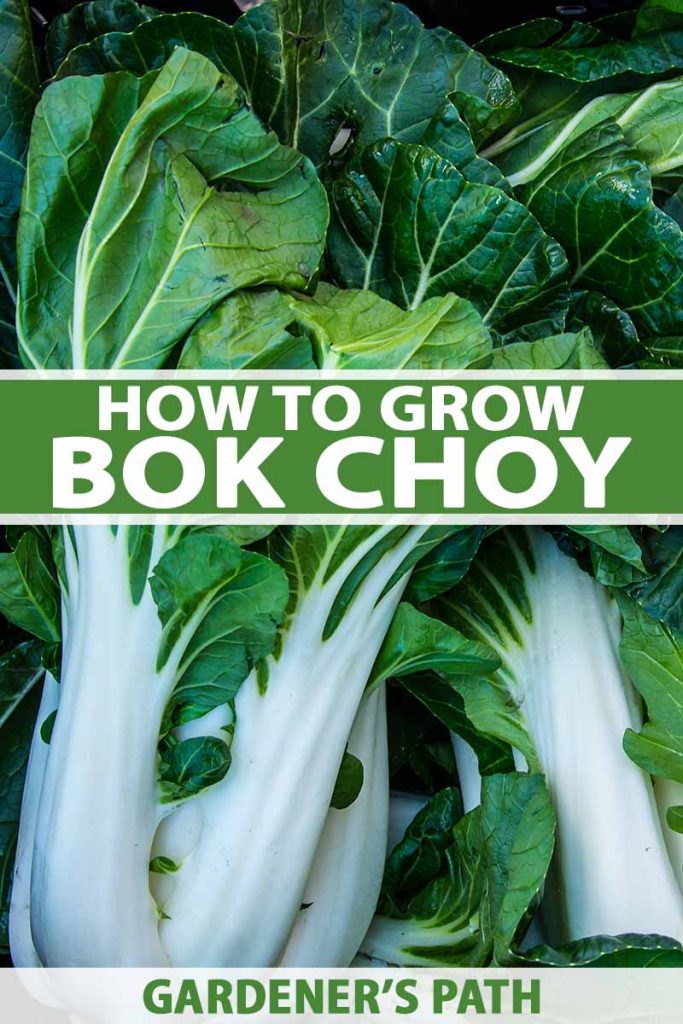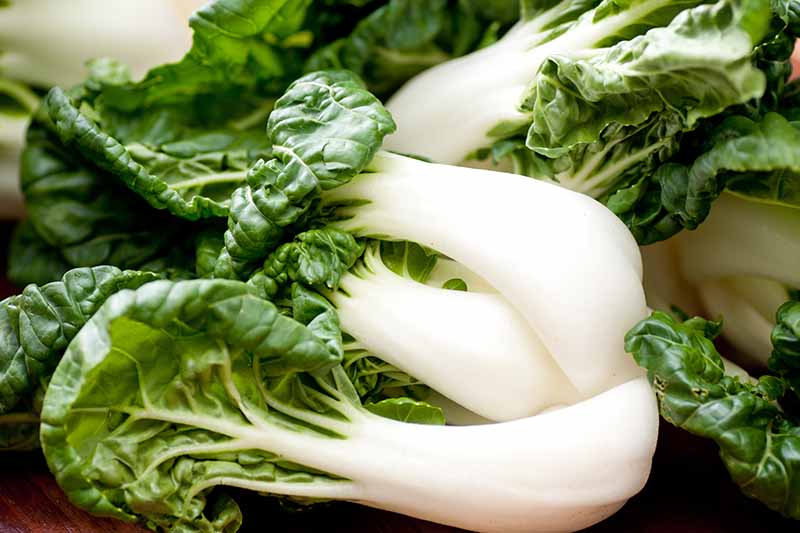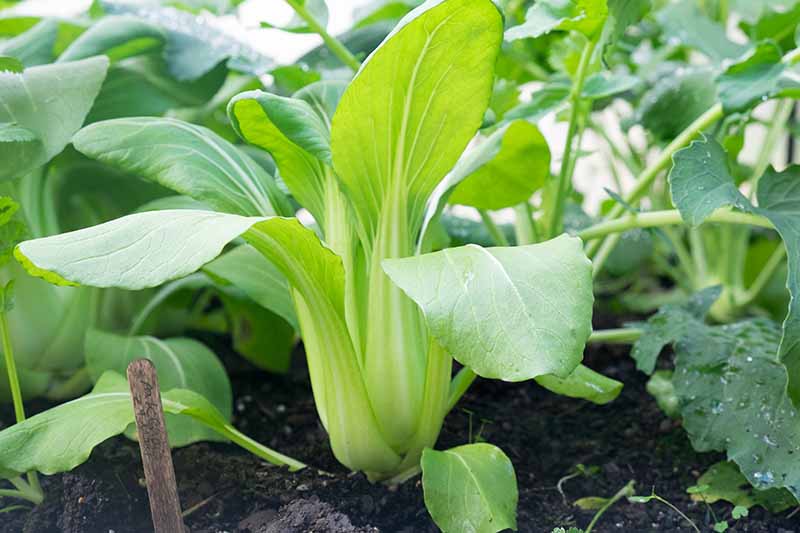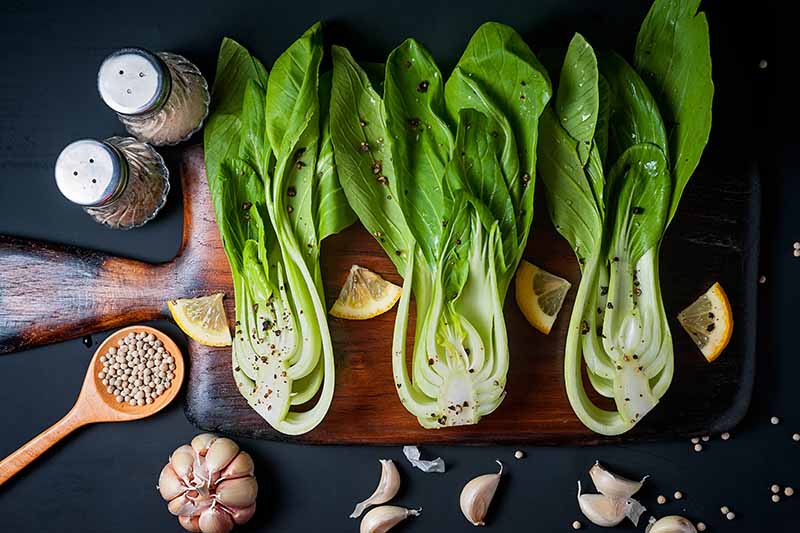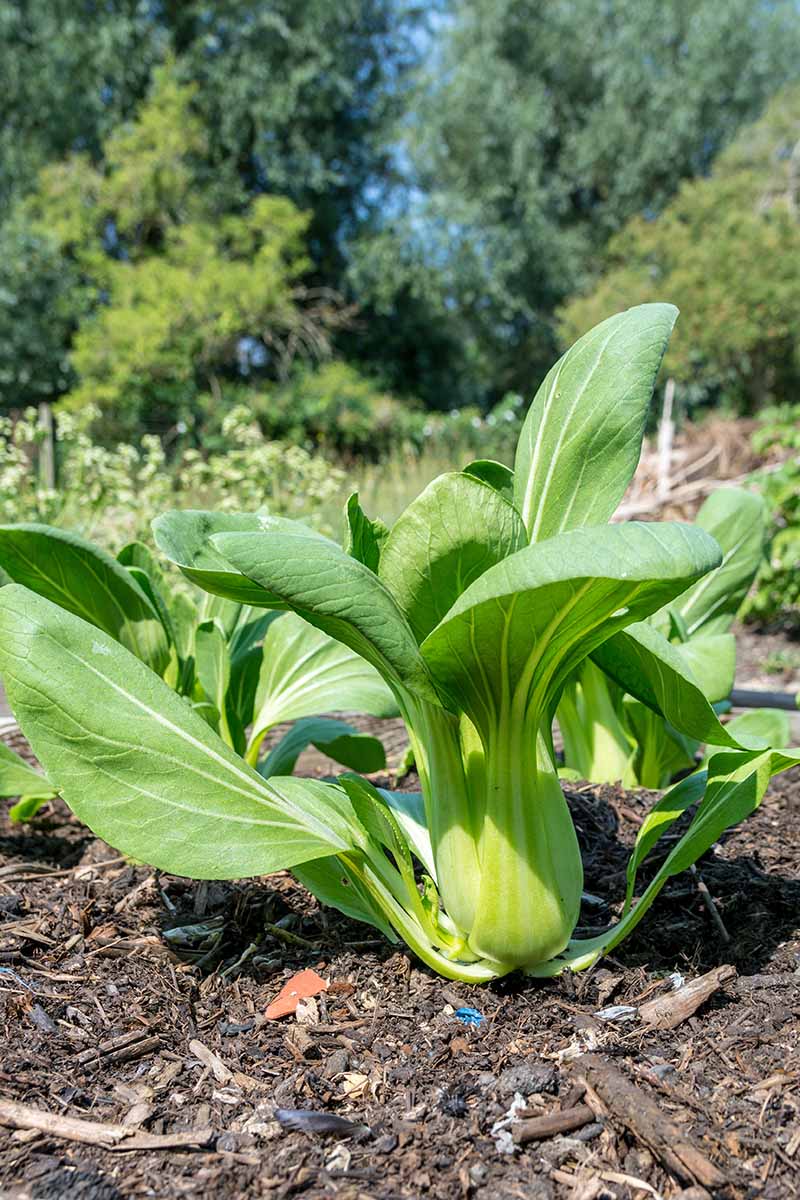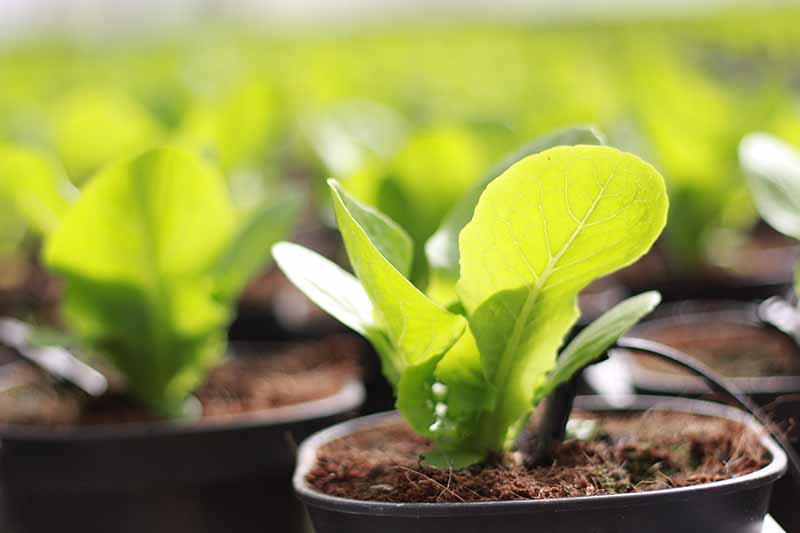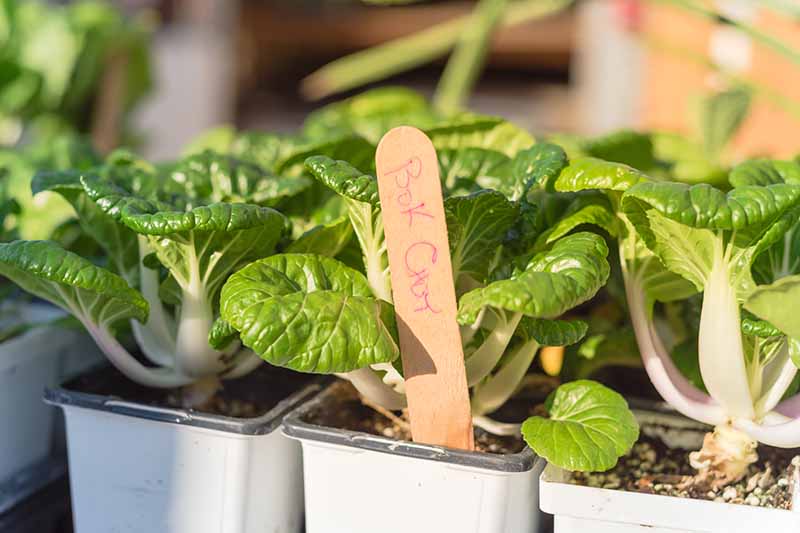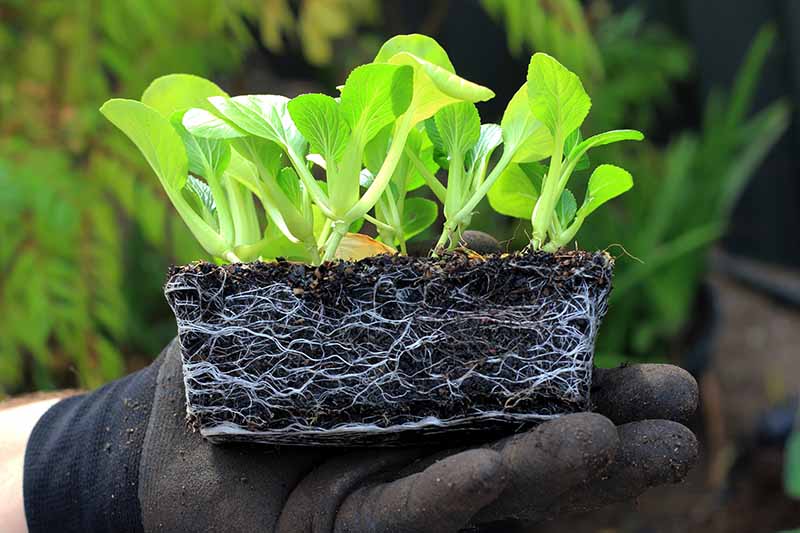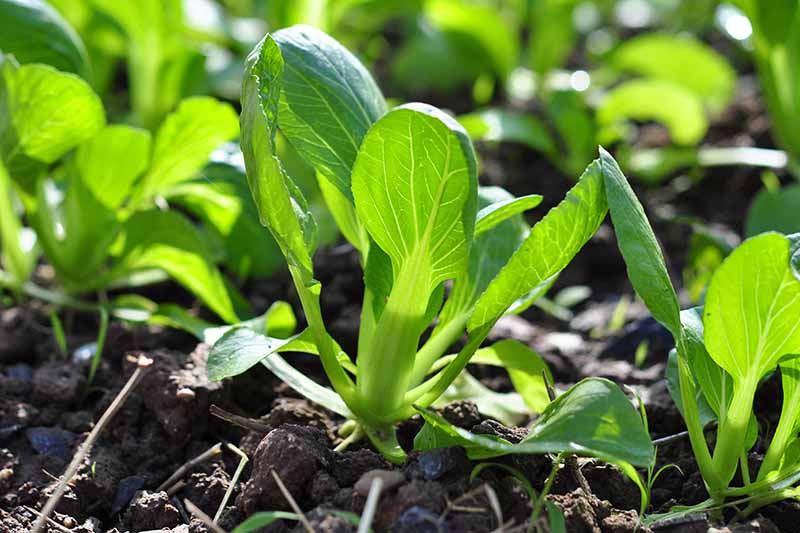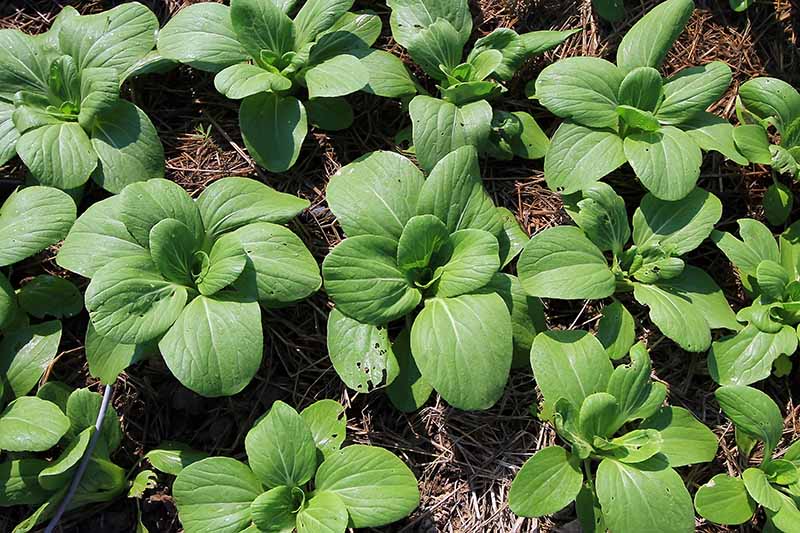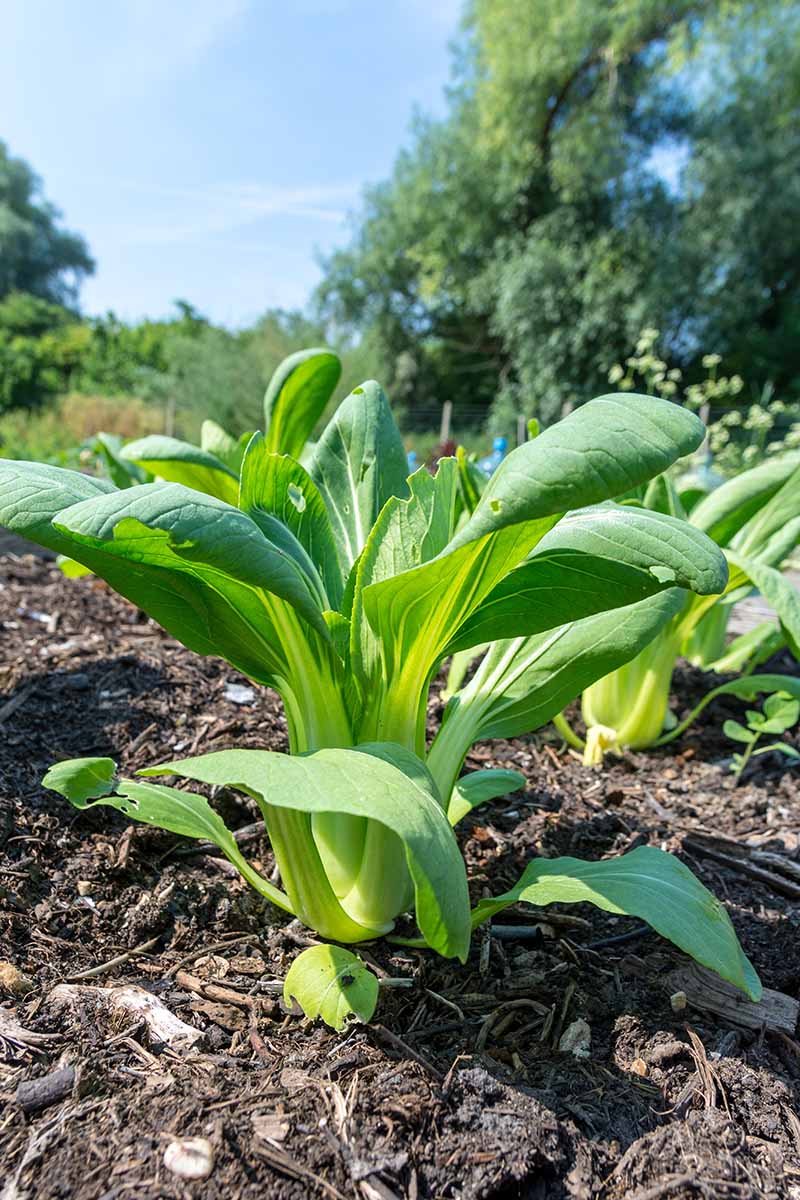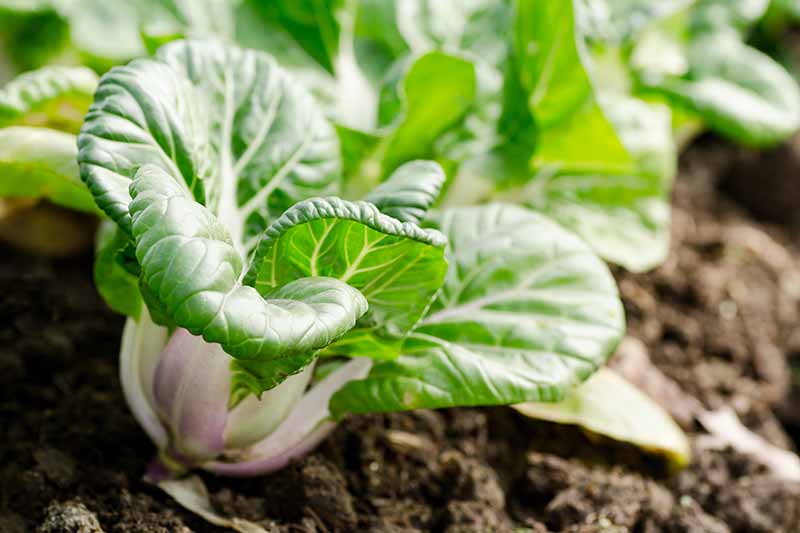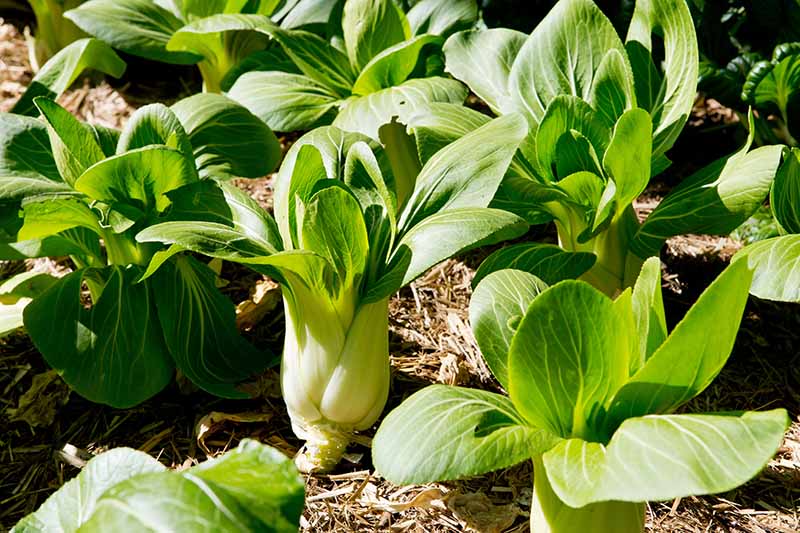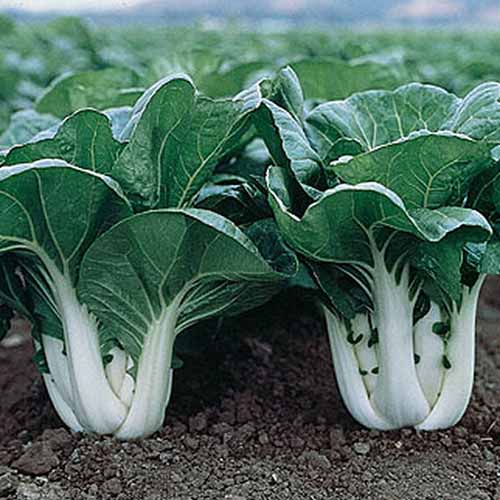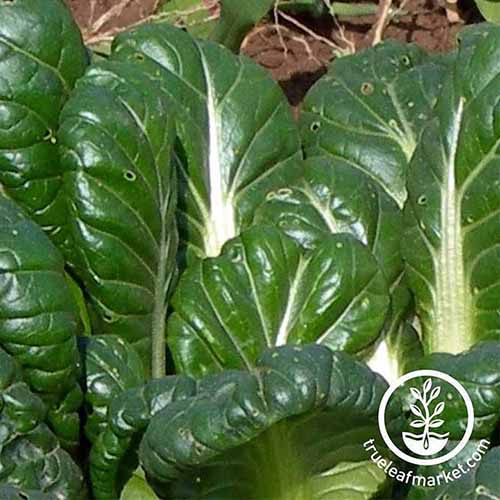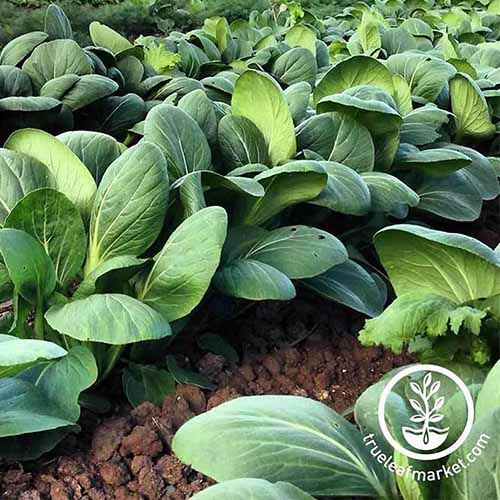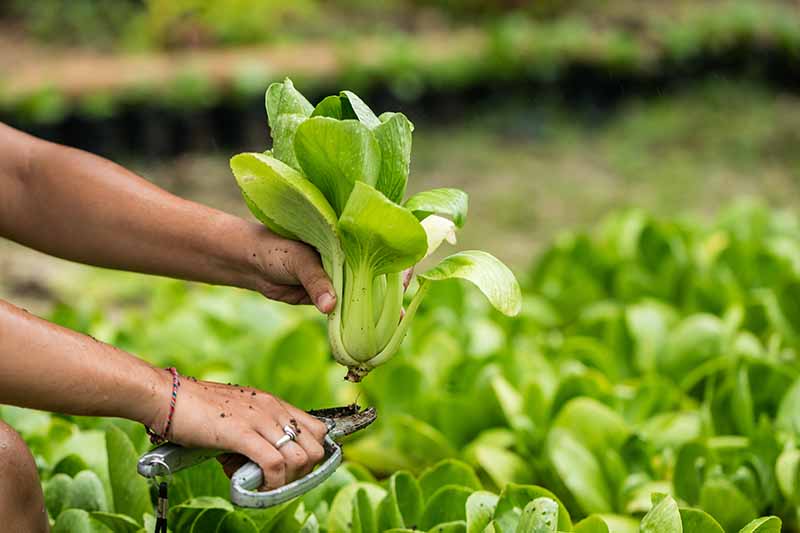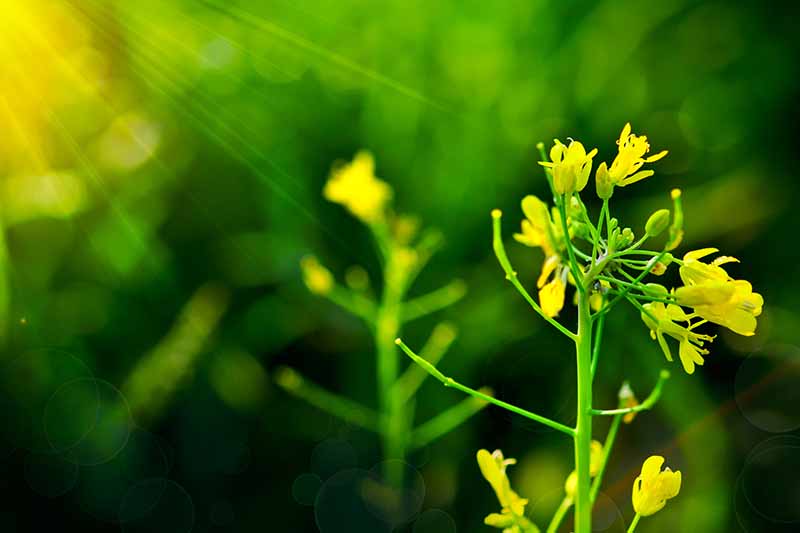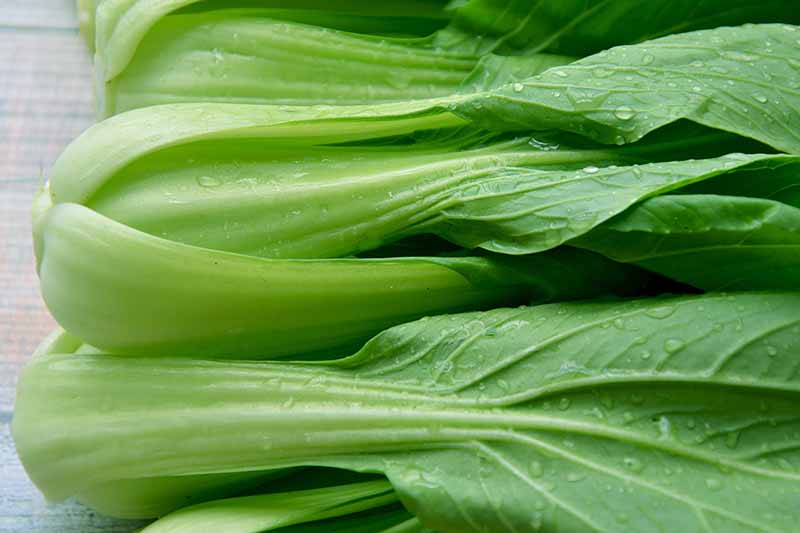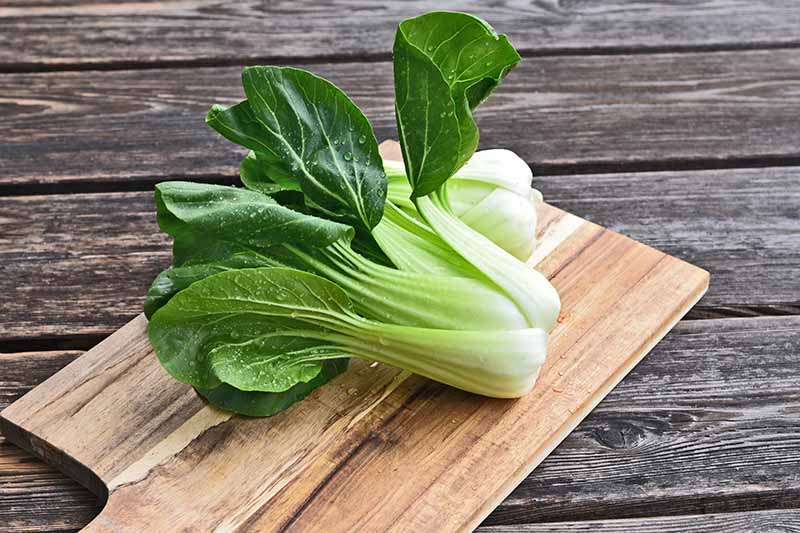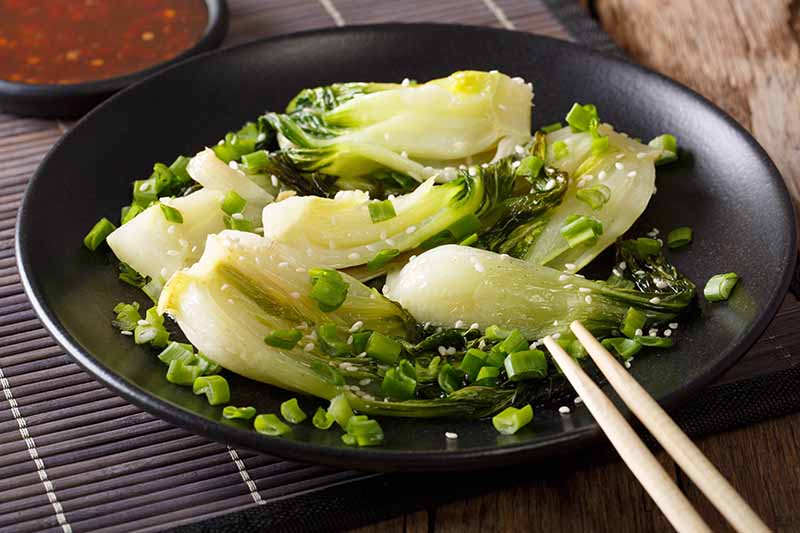The outer leaves are beautiful shades of light purple or green, and seem to open out like supporting ballerinas arching back to reveal the star of the show – the compact-headed, bulbous-bottomed central stalks and leaves. Like good supporting dancers, those outer leaves are pretty, but everyone wants to get to the main act – the sweet, juicy center. Steam them, braise them, stir-fry, or cook them in soup, they’re delicious! Eat them raw and you’ll get a hint of cabbage with a mustardy piquancy. We link to vendors to help you find relevant products. If you buy from one of our links, we may earn a commission.
What Is Bok Choy?
Sometimes referred to as “siu bak choy” (small white vegetable) so as not to confuse it with “dai bak choy” (big white vegetable – the napa cabbage) this cruciferous vegetable is a member of the Brassicaceae family.
Also referred to as pak choi, the variations of the name in English are derived from the phonetic translation of Chinese characters – the word choi or choy means “vegetable.” The bak, bok, or pak part means “white.” Bok choy is a biennial plant that is usually grown as an annual. It thrives in the cool season in locations with temperatures between 55 and 70°F. It doesn’t mind the odd light frost and can withstand slightly higher temperatures, so long as the soil is kept sufficiently moist. Certain heat-tolerant varieties are available to suit tropical environments – but it will not tolerate drought.
This quick-growing leafy green is used extensively in Asian cuisine. Its firm, crispy stalks have a mild flavor and maintain a delicious crunch when cooked. The soft, tender leaves have a mellow taste with a hint of peppery spice.
Like its close cousins kale and cabbage, bok choy packs a hefty nutritional punch. Low in calories, it’s a rich source of vitamins A, C, K, and folate. High in anti-inflammatory polyphenols, it also contains important minerals including calcium, iron, phosphorus, potassium, and magnesium.
Cultivation and History
Native to the Yangtze River Delta in China, bok choy has been grown as a food crop since the fifth century, most likely cultivated from native wild brassicas growing in the region. An important culinary ingredient, it was also used in traditional Chinese medicine.
Mentioned in the 16th century by the Chinese pharmacologist Li Shizhen in his “Compendium of Materia Medica” for its medicinal properties, this vegetable has since spread throughout southeast Asia and further afield. Bok choy was brought to Europe in the mid-18th century, and to America in the late 1800s by Chinese workers during the Gold Rush. Today, it’s grown nearly everywhere in the world.
Propagation
This member of the crucifer or mustard family is easily propagated from seed, as well as from transplants. It thrives in USDA Hardiness Zones 2 to 11.
From Seed
For a spring and early summer crop, sow seeds indoors in a seed starting mix four to five weeks before your estimated last frost date. Sow seeds quarter of an inch deep and spaced about an inch apart.
They should start to germinate in four to eight days. When seedlings grow to about two inches high, they will be ready to transplant. If you’re growing your crops in containers, choose pots that are at least six inches deep for dwarf varieties, and eight to 10 inches deep for full sized cultivars.
Keep them indoors in a sunny spot until all risk of frost has passed. You can also direct sow into your vegetable patch after your last frost date. You’ll need well-draining soil that’s rich in organic matter, so do a soil test and amend with compost as necessary. Sow seeds quarter of an inch deep and one to two inches apart. Thin them to three to five inches, depending on your variety.
You can enjoy baby greens in a salad or smoothie, or wait for them to mature before you harvest. If you are planting a fall crop, sow seeds directly in mid- to late summer, up to six weeks before your predicted first frost date. Keep them well watered and thin when seedlings are two to three inches tall. The amount of space you provide between each plant depends in part on what variety you are planting, so be sure to check your seed packets for instructions. You can also find more spacing tips here. If you plan to harvest at the baby stage, you can grow them closer together.
From Transplants
You can transplant seedlings into the garden or move containers outdoors once nighttime temperatures are holding above 50°F.
Be ready to protect your plants with a floating row cover if the temperature takes a dip after transplanting – if they feel the frost, they will think it’s winter and bolt as soon as temperatures rise. Transplant into well-draining soil that’s rich in organic matter; mix in some compost as necessary. If you’re in Zone 8 or higher, late plantings can grow as biennials.
These plants will go dormant in a mild winter, before growing again and eventually bolting the following season. The second season’s harvest will tend to be less tender and flavorsome – but you’ll be able to save the seeds for future planting. Successive plantings every two weeks work well if you’re looking for a continuous harvest. We take a closer look at bok choy planting times in our supplemental guide.
How to Grow
When choosing a spot in the garden, it’s wise not to plant in an area where you’ve previously grown other brassicas, as disease-causing fungi and bacteria can remain in the soil. Best practice here is to rotate crops to avoid planting the same type of vegetables in the same place year after year.
B. rapa can grow in full sun, but prefers partial shade. Give your plants at least three hours of sun every day, and they will be happy in your garden. Bok choy enjoys fertile, well-draining soil that is high in organic matter with a pH of 6.0-7.5. If your soil is rich or you have already amended with compost, you shouldn’t need to add extra nutrients. But if you see slow growth or pale leaves, feed with a high-nitrogen liquid fertilizer after transplanting for happy, healthy plants.
Water your veggies frequently, particularly in the fall. Keep the soil moist but not over-saturated, and be sure to water at the base of the plants. Try to avoid getting the leaves wet as this can encourage rot if plants are watered later in the day.
This plant loves both well-watered and well-drained soil. Whether you use sprinklers, drip tape, or a hose, water regularly so that the soil does not get a chance to dry out. Your goal is to keep the soil slightly damp, but not waterlogged. Keep the area free from weeds so they don’t crowd out your crops and compete for soil nutrients.
You can also place mulch around the plants to combat weeds and help to retain moisture. Remember to keep the mulching material one to two inches away from the base of each plant.
Companion Plants
Companion plants can have various benefits such as pest control and nutrient enhancement, so consider planting some of these together with your bok choy to keep it healthy and insect free.
To enhance growth, surround it with veggies such as beets, bush beans, or carrots. Intercropping will also help you to maximize garden space. Some claim that planting pungent plants like chamomile, garlic, or mint next to your bok choy will give it some extra flavor. Celery and thyme help to repel cabbage worms. Any type of onion is a good deterrent to root maggots, and rosemary, thyme, sage, cilantro, and nasturtiums can protect your crop against flea beetles and aphids. Unfortunately, this plant is prey to a wide range of pests and diseases. But with attentive care and good growing practices, most of these can easily be prevented or treated. Some varieties have large, crisp white stems contrasting with dark green leaves, while others have more delicate, pale stems and leaves. Here are some of our favorite cultivars:
Joi Choi
Standing straight and upright on its thick white stalks, this hybrid variety is distinctive in the garden.
‘Joi Choi’ Adaptable to a wide variety of growing conditions ‘Joi Choi’ is a vigorous, bolt resistant cultivar. Each plant typically yields 10 to 14 erect stalks that reach eight to 10 inches tall with dark green leaves. Expect 55 days to maturity. Packets containing 200 seeds are available at Burpee.
Tatsoi Rosette
The ‘Tatsoi Rosette’ variety is pretty with its dark green, teardrop-shaped leaves that arrange themselves around the center of the plant.
‘Tatsoi Rosette’ On the table, the stalks of this cultivar are sweet and tender, and the leaves are tasty in salads. Plant six to eight inches apart, so that the leaves can spread out. This fast growing heirloom prefers cooler temperatures and is suited to Zones 3 to 7. Matures in 50 days. Find packets of seeds in a variety of sizes at True Leaf Market.
White Stem
‘White Stem’ is hardy and handles frost a bit better than other varieties, and can be grown successfully in Zones 1 to 9.
‘White Stem’ When fully mature, in about 70 days, its dark green, fan-like leaves have a mild, peppery flavor. This heirloom variety can be harvested early for tender baby greens. It is delicious in a variety of dishes, especially Asian stir-fries. You can find packets of seeds in various sizes from True Leaf Market and also at Eden Brothers.
Managing Pests and Disease
Insects
There are a number of pests that love bok choy as much as we do. Floating row covers can help keep them off your crops. The main ones to watch out for are:
Aphids
These pesky sap-suckers enjoy feeding on most brassicas, and bok choy is no exception. They can cause stunted growth and wilting leaves, and large infestations can kill your crops. Aphids can also contribute to the spread of turnip mosaic virus. If there aren’t too many of them, you can wash them off with a hose. For larger infestations, spray with neem oil or insecticidal soap. Read more about controlling aphid infestation here.
Cabbage Loopers
This insidious inchworm is about 1.5 to 2 inches long, and it loves chewing large holes in your greenery. Natural predators such as ladybugs and spiders usually keep these pests under control by eating the eggs and larvae. You can also use Bt or pyrethrins to keep these caterpillars off your crops. Read more about cabbage looper control here.
Diamondback Moths
It’s not the actual moth that does the damage in this case, it’s the larvae. Hiding between the upper and lower leaf surfaces, they chew little holes on the bottom of the leaves, and can be seen coming through the tops. Bt is effective at controlling these pests.
Flea Beetles
What they lack in size, flea beetles make up for in damage. Tiny holes dotted all over your greens are a sign that these little black beetles have taken up residence. You can spray with neem oil or put down diatomaceous earth around the plants to control these critters. Read more about combating flea beetles here. Get tips on identifying and controlling bok choy pests here.
Disease
The presence of pests can also contribute to the spread of bacterial and fungal disease. The most common ones to look out for are:
Black Rot
Caused by a bacterium, Xanthomonas campestris pv. campestris, yellow or dark lesions will appear on the edges of leaves. They’ll gradually turn black, eventually killing the whole plant. Learn more about how to protect your crops from black rot here.
Damping Off
This condition is usually caused by a fungus, either Rhizoctonia spp., Fusarium spp., or the water mold Pythium spp. that live in the soil. It mostly affects seedlings and young plants by attacking the roots and killing them. Read more about damping off and how to treat and prevent it here.
Downy Mildew
Downy mildew is caused by the water mold Peronspora parasitica. It is mostly an issue in warm, moist conditions. The leaves will develop small yellowish spots on the top which gradually get larger. When you turn the leaf over, there’s often a characteristic white powdery substance that looks like mildew on the underside. Treatment with fungicides is usually successful. Sufficient airflow between plants and regular weeding helps keep this disease at bay. You can read more about downy mildew here.
Turnip Mosaic Virus
Spread by aphids and an overgrowth of weeds, turnip mosaic virus can be devastating, especially to young plants. Signs can vary from yellow spots on the leaves to large, light green lesions. Keeping weeds and aphids under control using integrated pest management is the best way to prevent this disease. Read more about identifying and preventing turnip mosaic virus here. Or find tips on identifying and treating various bok choy diseases here.
Harvesting
Depending on the variety, you can generally harvest mature bok choy five to eight weeks after germination. You can also harvest tender baby greens at four to five weeks, when they are six to 10 inches tall.
Hand harvest your plants during the cooler part of the day, to reduce moisture loss. Cut the plants just above the soil line, all in one snip. Alternatively, you can use the “cut and come again” method where you harvest the outer, older leaves approximately 1 inch above the soil line, keeping the center leaves intact so that the plant can keep growing. After harvesting, move your vegetables to a cool location as soon as possible. They are prone to wilting in the summer sun, so place them in the shade after picking, and take them to the kitchen quickly to maintain their crisp texture. Read more tips on harvesting bok choy here.
Seed Saving
If you want to save seeds to plant next year, you’ll need to allow your bok choy to bolt. The plants will grow tall and produce flowers, which will eventually fall off and be replaced by seed pods if pollination was successful.
Harvest the seed pods when they are brown and dry – this is an indication that they are getting ready to burst. Just make sure you don’t wait too long or they will open up and release their seeds into the garden. Cut at the base of each stalk with garden shears when the plant is dry; it’s best to avoid early mornings or shortly after after watering. Cut the pods off and place them in a bucket or paper bag. If any moisture remains, allow them to dry out completely in a cool, dry place. If you notice that some pods have already burst, this means it’s going to be easy to separate the remaining seeds from their pods. To separate the seeds from the chaff, twist the dry pods over a fine mesh strainer or screen. The small seeds will fall through, leaving the dry plant material behind. Pour the seeds into a lidded container or envelope, and label it with the plant name and date before placing it in a cool, dry location for storage. Seeds can remain viable for up to five years.
Preserving
Proper storage of this leafy green will preserve its nutrients, as well as its flavor.
If you don’t plan to eat your bok choy the same day that you harvest it, don’t wash it – damp vegetables will rot faster in the fridge. You can keep whole harvested plants intact, or separate the stems and store them in a zippered bag. Cut holes in the bag for air circulation and put them in the crisper. This plant is best eaten within four to five days, although it can last for up to three weeks in the refrigerator.
If you plan to eat your harvest right away, the most thorough way to wash and prepare it is to break off the larger stems and then, when you get to the more tightly-packed inner stems, slice off the base to separate the remaining stems and leaves. This allows you to clean all the remaining dirt and grit from between the stems. Rinse well in cool water. Dry them with paper towels or a salad spinner and use immediately, or wrap in paper towels and place in a zip-top plastic bag in the refrigerator and use within two to three days. Don’t have a salad spinner? Our sister site, Foodal, has a handy guide to help you find the best model for your kitchen. You can also place the separated cleaned stalks into a jar of cold water for a crisp snack that’s ready to enjoy. Put it in the fridge, and eat within two days. Freezing is an option, if you treat the stalks properly. Follow these easy instructions to freeze your homegrown harvest: To keep your veggie crop long-term, consider pressure canning it for shelf-stable storage for up to a year. Dehydration is another option, as is pickling.
Cooking Ideas
This nutritious vegetable is a low calorie source of dietary fiber, protein, and a variety of healthy vitamins and nutrients. It offers vitamins A, C, K, and several B vitamins as well as phosphorus, potassium, and manganese. A one-cup serving contains only nine calories.
Tiny “baby” bok choy can be eaten raw or cooked. They have a sweet and slightly piquant taste. Large, mature leaves and stems have a milder flavor. If you let the plants bolt and you don’t plan to save seeds later in the season, the inflorescences (flowering stems) can be stir-fried like broccoli.
You can use this nutrient-packed leafy vegetable in fresh salads, preserve the generously proportioned leaves in a spicy homemade kimchi, or stir-fry them with garlic and soy or oyster sauce for a simple Chinese side dish. Bok choy is also delicious as a roasted vegetable. The leaves become crispy and the stalks soften and become a bit sweeter.
Quick Reference Growing Guide
If you enjoyed this guide, try these suggestions for further reading on brassica and cole crops:
How to Grow Broccoli, a Cool Weather Crop How to Grow Savoy Cabbage How to Plant and Grow Turnips
© Ask the Experts, LLC. ALL RIGHTS RESERVED. See our TOS for more details. Product photos via Burpee and True Leaf Market. Uncredited photos: Shutterstock. Significantly revised and expanded from an article originally written by Drew John. With additional writing and editing by Allison Sidhu.
